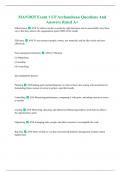MAN3025 Exam 1 UF Archambeau Questions And
Answers Rated A+
Effectiveness ANS To achieve results, to make the right decisions, and to successfully carry them
out so that they achieve the organizations goals ENDS of the results
Efficiency ANS To use resources-people, money, raw materials, and the like-wisely and cost-
effectively
Four management functions ANS (1) Planning
(2) Organizing
(3) Leading
(4) Controlling
aka management process
Planning ANS Setting goals and deciding how to achieve them; also coping with uncertainty by
formulating future courses of action to achieve specified results
Controlling ANS Monitoring performance, comparing it with goals, and taking corrective action
as needed
Leading ANS Motivating, directing, and otherwise influencing people to work hard to achieve
the organization's goals
Organizing ANS Arranging tasks, people, and other resources to accomplish the work
Big Data ANS Stores of data so vast that conventional database management systems cannot
handle them
,Cloud Computing ANS The storing of software and data on gigantic collections of computers
located away from a company's principal site
Knowledge Management ANS Implementation of systems and practices to increase the sharing
of knowledge and information throughout an organization
Soft Skills ANS Ability to motivate, inspire trust, and communicate with others, interpersonal
"people" skills
Decisional Roles ANS Roles in which managers use information to make decisions to solve
problems or to take advantage of opportunities. There are four types:
(1) entrepreneur
(2) disturbance handler
(3) resource allocator
(4) negotiator
Informational Roles ANS Roles in which managers receive and communicate information:
(1) Monitor
(2) Disseminator
(3) Spokesperson
Interpersonal Roles ANS Roles in which managers interact with people inside and outside their
work units:
(1) Figurehead
(2) Leader
(3) Liaison
Attitude ANS A learned predisposition toward a given object
,Career Readiness ANS Extent to which a person posses employers' desired knowledge, skills,
and attributes
Meaningfulness ANS Sense of belonging to and serving something bigger than oneself
Proactive learning orientation ANS Desire for personal development through learning and
improving characteristics such as knowledge and soft skills
Resilience ANS Ability to bounce back from adversity and to remain energized when faced whit
challenges
Process ANS Series of actions followed to achieve a desired result
Contemporary Perspective ANS In contrast to the historical perspective, the business approach
that includes the systems, contingency, and quality-management viewpoints. (1960s-persent)
includes the systems, contingency, and quality-management viewpoints.
Historical Perspective ANS In contrast to the contemporary perspective, the view of management
that includes the classical, behavioral, and quantitative viewpoints. (1911 to 1950s) includes the
classical, behavioral, and quantitative viewpoints.
Classical Viewpoint ANS In the historical perspective, the viewpoint that emphasizes finding
ways to manage work more efficiently; it has two branches-scientific management and administrative
management
Scientific management ANS Management approach that emphasizes the scientific study of work
methods to improve the productivity of individual workers
Administrative management ANS Management concerned with managing the total organization
Behavioral Viewpoint ANS Emphasizes the importance of understanding behavior and of
motivating toward achievement.
, Hawthorne Effect ANS Employees work harder if they receive added attention, if they think
managers care about their welfare, and if supervisors pay special attention to them.
Human relations movement ANS The movement that proposed that better human relations could
increase worker productivity
Behavioral Science ANS Relies on scientific research of developing theories about human
behavior that can be used to provide practical tools for managers.
Quantitative Management ANS The application to management of quantitative techniques, such
as statistics or computer simulations; it has two branches-management science and operations
management
Management Science ANS Sometimes called operations research; branch of quantitative
management; focuses on using mathematics to aid in problem solving and decision making
Operations management ANS A branch of quantitative management; focuses on managing the
production and delivery of an organization's products or services more effectively
Feedback ANS Information about the reaction of the environment to the output that affects the
inputs
Inputs ANS the people, money, information, equipment, and materials required to produce an
organization's goods or services
Outputs ANS the products, services, profits, losses, employee satisfaction or discontent, and the
like that are produced by the organization
Transformational Processes ANS An organization's capabilities in management, internal
processes, and technology that are applied to converting inputs into outputs. The main activity of the
organization is to transform inputs into outputs.




